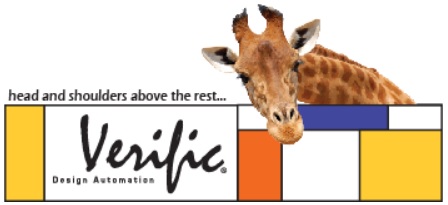 Today, Semiwiki profiles Verific Design Automation, perhaps the most popular company at DAC (when it’s an in-person event) because of its giveaway –– a 10”stuffed giraffe for anyone who walks up to its booth and listens to its story.
Today, Semiwiki profiles Verific Design Automation, perhaps the most popular company at DAC (when it’s an in-person event) because of its giveaway –– a 10”stuffed giraffe for anyone who walks up to its booth and listens to its story.
But, Verific is also a popular EDA company for more reasons than its tradeshow giveaway. If you’re using any type of FPGA implementation or EDA verification tool, Verific is probably inside. That’s because it is the leading provider of SystemVerilog, Verilog, VHDL and UPF parsers and elaborators used by startups, emerging companies and some of the best-known semiconductor companies worldwide. Parser platforms from Verific eliminate costly internal development of front-end EDA software, accelerating time to market with vastly improved quality. Need proof? Verific’s licensees have shipped more than 80,000 copies of its software since it was founded in 1999.
The image of a giraffe is used as mascot and also a recurring theme. On its website, one cheeky giraffe leans her head over the logo, a nod to Verific’s stature in the industry. Several of its employees tower over many of us, including Michiel Ligthart, Verific’s president and COO, who stands at about 6’4,” and whom I recently interviewed about the company and its success. Before we began, Michiel wanted to emphasize that although this segment is called ‘the CEO interview’, he is not Verific’s CEO. Verific’s founder and CTO Rob Dekker (also 6’4” by the way) is the CEO of record.
Once you finish reading my interview with Michiel, you will understand why Verific has the well-earned reputation of being, “Head and shoulders above the rest.”
What brought you to semiconductors?
I was studying Electrical Engineering at Delft University of Technology in the Netherlands. I was interested in digital design and took a new course based on “Introduction to VLSI Systems” by Carver Mead and Lynn Conway. That’s how I learned about chip design in general. Later on I got an internship at Philips Research in the fields of semiconductor test and EDA, and afterward went to Signetics Research Labs in California. Early on, I was involved with research activities in logic synthesis, including a stint as a visiting scholar at the Center for Integrated Systems at Stanford University.
What is the Verific backstory?
Rob founded Verific in 1999 after working for Exemplar Logic, acquired by Mentor Graphics (now Siemens EDA) in 1995. Rob, looking for a change of pace, liked the startup experience and wanted to start one of his own. He had an idea about developing verification software but had no specific application in mind. While working through his idea he knew that whatever he did, he would need a Verilog parser and began building one. Several EDA companies asked to license the parser and so that became the business. And here I need to give a shout out to Real Intent, one of those early adopters and still a licensee twenty years later !
Lawrence Neukom was Rob’s first hire, a year or so after Verific’s founding. I recommended Lawrence, who I knew from Theseus Logic, an asynchronous logic startup and also an early Verific customer. I joined a few years later.
Verific celebrates its 22nd birthday this year. What is the secret to your success and core strengths?
We credit our longevity and our great success to our corporate culture. We believe we have a primary responsibility to our customers, secondly to our employees, and thirdly to the environment in which we operate at large, not just the semiconductor industry. If we fulfill all these responsibilities, we automatically fulfill our commitment to shareholders.
We emphasize the quality of our product, and proven by our many satisfied customers we have succeeded. Our attention to customer needs and requirements by providing first-class support is an important part of that success. They must feel we are part of their R&D team.
What customer challenges are you addressing?
We have an interesting challenge. We implement IEEE standards. EDA companies who do not use our parsers may at times have a slightly different implementation or interpretation of that standard in their simulators or synthesis tools. Now we could claim that we got it right and everybody else has to change, but that would not be very helpful to the end-users. Instead, we try to match that other tool’s behavior so the end-user is not dead in the water, The challenge is that we only find this out by trial and error. Our customers find these mismatches in the field, report them to us and we try to be compliant with both the IEEE standard and this other EDA tool.
I recently reported on the DARPA toolbox. How will Verific’s relationship with DARPA help the industry?
We always had an academic program, though admittedly ad hoc, where we provide linkable library access. Over the years, several interesting university projects have used Verific. DARPA is helping by streamlining an actual process, giving access to EDA software for U.S. academic projects. We already have our first engagement through the DARPA toolbox with the University of Utah.
Our agreement with DARPA is not part of the open-source movement.
What other trends are you seeing?
We see a really big EDA push out of China as it builds up its EDA infrastructure. In the last 12 months, we closed four new licenses there. A host of semiconductor companies are getting funding here in the U.S., which bodes well for EDA companies as well
Another big growth area for us is in the semiconductor space with INVIO, our Python-based higher-level API set for SystemVerilog, VHDL, and UPF flows ,built on top of our traditional Verific platform. INVIO is especially useful for companies that are developing their own design methodologies, not necessarily supported by off-the-shelf tools. AI chip design groups with strict power, test and scalability requirements are able to build their own methodologies and flows. Custom processors for large compute farms are another good example.
How has the pandemic affected Verific and its customers?
Not at all. When the pandemic struck, we closed our offices and took our laptops home. We already had VPN networks in place and were Zoom users for several years. We secured some additional cloud back up and didn’t miss a beat. Our customers didn’t seem to have any significantly negative effects either.
However, not everyone was that fortunate. Restaurants and coffee shops that we normally patronize around our offices in Alameda, Calif., and Kolkata, India, were very much affected, along with many other people in the services industries. As a company where no paycheck was ever in jeopardy we decided to make significant contributions to food banks in our local communities, which for us are Alameda and Kolkata.
As an entrepreneur, what advice would you give someone founding a startup or thinking about starting one?
If you have a good idea, go ahead and try it. If you do, always listen to your customers. That said, also do not always listen to your customers. You will know when to listen and when to do it your way.
Also Read:
CEO Interview: Srinath Anantharaman of Cliosoft
CEO Interview: Rich Weber of Semifore, Inc.
CEO Interview: Dr. Rick Shen of eMemory
Share this post via:





Comments
There are no comments yet.
You must register or log in to view/post comments.